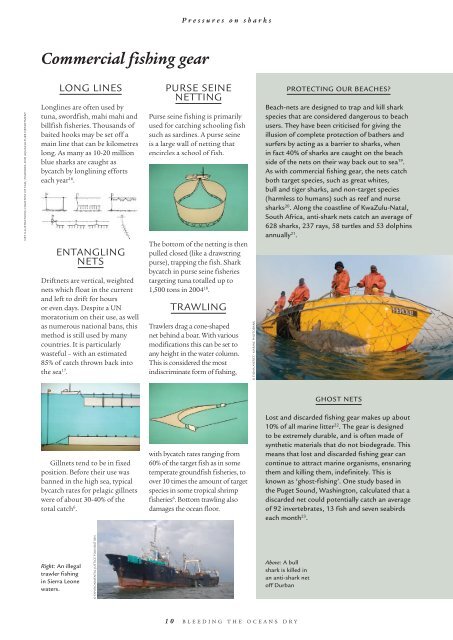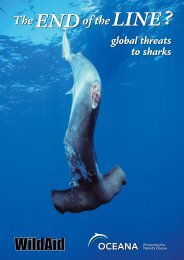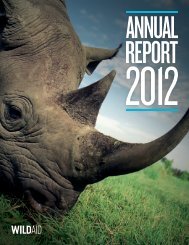Bleeding the Oceans Dry - WildAid
Bleeding the Oceans Dry - WildAid
Bleeding the Oceans Dry - WildAid
- No tags were found...
You also want an ePaper? Increase the reach of your titles
YUMPU automatically turns print PDFs into web optimized ePapers that Google loves.
P r e s s u r e s o n s h a r k sCommercial fishing gearNet illustrations Courtesy of FAO/ Fisheries and Aquaculture DepartmentLong linesLonglines are often used bytuna, swordfish, mahi mahi andbillfish fisheries. Thousands ofbaited hooks may be set off amain line that can be kilometreslong. As many as 10-20 millionblue sharks are caught asbycatch by longlining effortseach year 16 .EntanglingnetsDriftnets are vertical, weightednets which float in <strong>the</strong> currentand left to drift for hoursor even days. Despite a UNmoratorium on <strong>the</strong>ir use, as wellas numerous national bans, thismethod is still used by manycountries. It is particularlywasteful – with an estimated85% of catch thrown back into<strong>the</strong> sea 17 .Purse seinenettingPurse seine fishing is primarilyused for catching schooling fishsuch as sardines. A purse seineis a large wall of netting thatencircles a school of fish.The bottom of <strong>the</strong> netting is <strong>the</strong>npulled closed (like a drawstringpurse), trapping <strong>the</strong> fish. Sharkbycatch in purse seine fisheriestargeting tuna totalled up to1,500 tons in 2004 18 .TrawlingTrawlers drag a cone-shapednet behind a boat. With variousmodifications this can be set toany height in <strong>the</strong> water column.This is considered <strong>the</strong> mostindiscriminate form of fishing,© Fiona Ayerst/ Marine PhotobankProtecting our beaches?Beach-nets are designed to trap and kill sharkspecies that are considered dangerous to beachusers. They have been criticised for giving <strong>the</strong>illusion of complete protection of ba<strong>the</strong>rs andsurfers by acting as a barrier to sharks, whenin fact 40% of sharks are caught on <strong>the</strong> beachside of <strong>the</strong> nets on <strong>the</strong>ir way back out to sea 19 .As with commercial fishing gear, <strong>the</strong> nets catchboth target species, such as great whites,bull and tiger sharks, and non-target species(harmless to humans) such as reef and nursesharks 20 . Along <strong>the</strong> coastline of KwaZulu-Natal,South Africa, anti-shark nets catch an average of628 sharks, 237 rays, 58 turtles and 53 dolphinsannually 21 .Ghost netsGillnets tend to be in fixedposition. Before <strong>the</strong>ir use wasbanned in <strong>the</strong> high sea, typicalbycatch rates for pelagic gillnetswere of about 30-40% of <strong>the</strong>total catch 6 .with bycatch rates ranging from60% of <strong>the</strong> target fish as in sometemperate groundfish fisheries, toover 10 times <strong>the</strong> amount of targetspecies in some tropical shrimpfisheries 6 . Bottom trawling alsodamages <strong>the</strong> ocean floor.Lost and discarded fishing gear makes up about10% of all marine litter 22 . The gear is designedto be extremely durable, and is often made ofsyn<strong>the</strong>tic materials that do not biodegrade. Thismeans that lost and discarded fishing gear cancontinue to attract marine organisms, ensnaring<strong>the</strong>m and killing <strong>the</strong>m, indefinitely. This isknown as ‘ghost-fishing’. One study based in<strong>the</strong> Puget Sound, Washington, calculated that adiscarded net could potentially catch an averageof 92 invertebrates, 13 fish and seven seabirdseach month 23 .Right: An illegaltrawler fishingin Sierra Leonewaters.© Environmental Justice FoundationAbove: A bullshark is killed inan anti-shark netoff Durban1 0 b l e e d i n g t h e o c e a n s d r y





